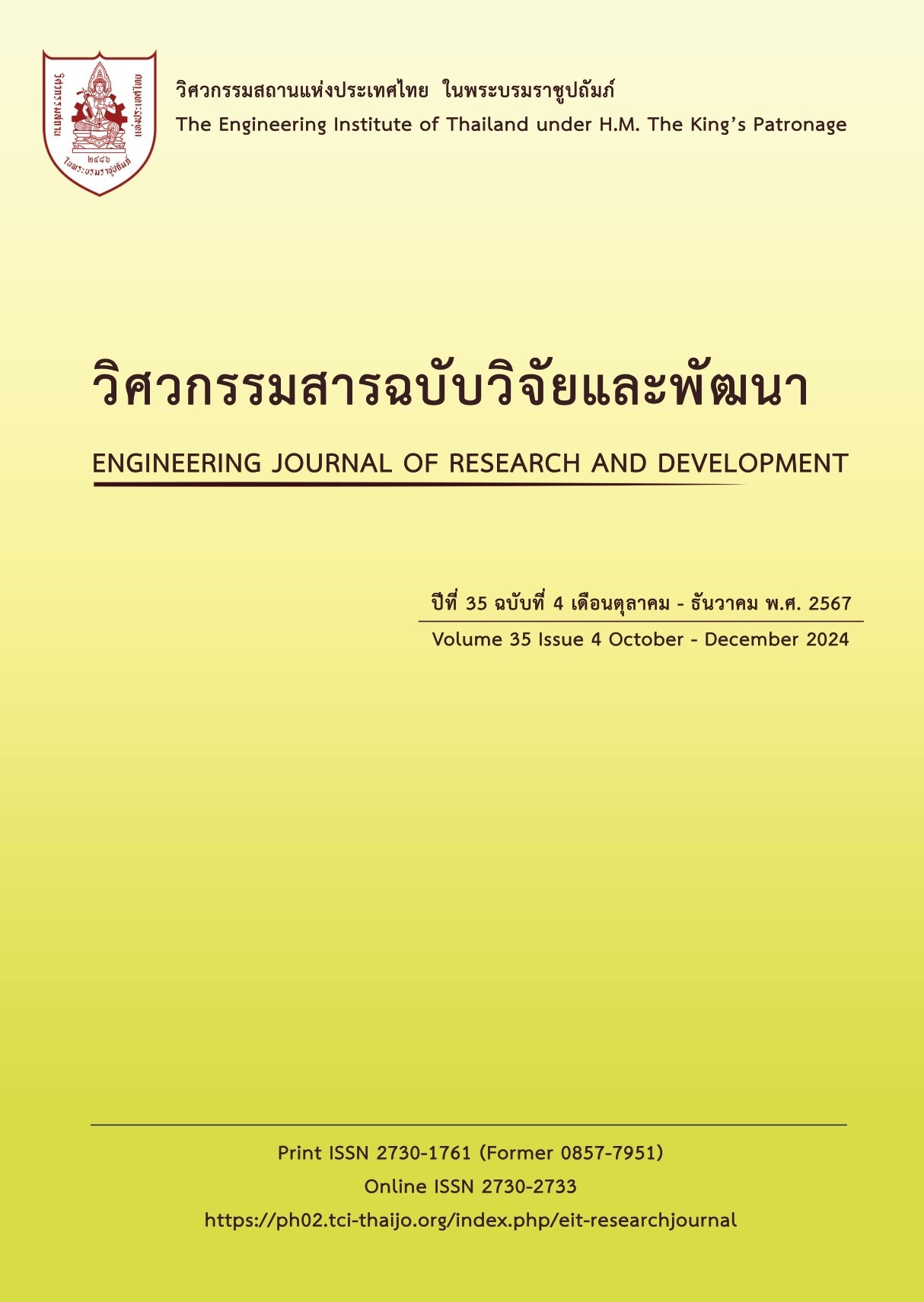SIMULATION ANALYSIS OF THE REINFORCED EARTHQUAKE RESISTANCE OF RC BUILDING STRUCTURE MODEL WITH GLASS FIBER REINFORCED POLYMER USING BRACED FRAME SYSTEM
Main Article Content
Abstract
This research aimed to study simulation analysis of the reinforced earthquake resistance of RC building structure model with glass fiber reinforced polymer using braced frame system. The size of reinforced concrete rigid frame used in the study was a 4000 mm in width and 3000 mm in height to simulate the strengthened behavior with glass fiber reinforced polymer by using braced frame system in bracing consisted of 4 types: X-braced frame, V-braced frame, Inverted V-braced frame, and Diagonal braced frame. The performance of the reinforced concrete rigid frame was evaluated using non-linear statics. The study results were found that: The X-braced bracing model provided the highest base strength compared to V-braced, Inverted V-braced and Diagonal braced model. The increased cross-sectional area ratio of the materials in bracing reinforced concrete rigid frame did not affect the increased strength of reinforced concrete rigid frame. Therefore, reinforced concrete materials in cross-section using reinforced materials with the lowest cross-section were sufficient to resist earthquake force. When comparing to deformed bar, the use of glass fiber reinforced polymer in cross-section can be used to replace deformed bar effectively.
Article Details

This work is licensed under a Creative Commons Attribution-NonCommercial-NoDerivatives 4.0 International License.
The published articles are copyright of the Engineering Journal of Research and Development, The Engineering Institute of Thailand Under H.M. The King's Patronage (EIT).
References
Meteorological Department, Earthquake Report in Thailand and Adjacent Areas in June 2017 Seismological Bureau, 2017. Available from :
https://earthquake.tmd.go.th/report/file/seismo-report-1504512433.pdf [Accessed 25 May 2023].
American Society of Civil Engineering , ASCE/SEI 41-23:2023. Seismic Evaluation and Retrofit of Existing Buildings . USA, 2013
Xu, S. and Niu, D. Seismic behavior of reinforced concrete braced frame. ACI Structural Journal, 2003, 100, pp. 120-125.
Khaloo, A.R. and Mahdi Mohseni, M. Nonlinear seismic behavior of RC frames with RC braces. Asian Journal of Civil Engineering, 2008, 9(6), pp. 577-592.
Desai, J.P. et al. Seismic response of R.C. braced frames. Computers and Structures, 2017,29(4), pp. 557-568.
Abou-Elfath, H. and Ghobarah, A. Behaviour of reinforced concrete frames rehabilitated with concentric steel bracing. Canadian
Journal of Civil Engineering, 2000, 27, pp. 433-444.
Maheri, M.R. et al. Pushover tests on steel X-braced and knee-braced RC frames. Engineering Structures, 2003, 25, pp. 1697–1705.
Ahiwale , D.D. et al. Seismic performance assessment of reinforced concrete frames with different bracing systems. Innovative Infrastructure
Solutions, 2023, 8, pp. 1–18
Poluraju, P. and Nageswara Rao, P.V.S. Pushover analysis of reinforced concrete frame structure using SAP 2000. International Journal
of Earth Sciences and Engineering, 2011, 4(6), pp. 684-690.
Hakim, R.A. et al. Application of Pushover Analysis for Evaluating Seismic Performance of RC Building. International Journal of
Engineering Research & Technology (IJERT), 2014, 3(1), pp. 1657–1662.
Milheiro, J. et al. Evaluation of The Contribution of Masonry Infill Panels on The Seismic Behavior of Two Existing Reinforced
Concrete Buildings. KSCE Journal of Civil Engineering, 2016, 20(4), pp. 1365–1374.
American Society for Testing and Materials. ASTM D7205-06:2006. Standard Test Method for Tensile Properties of Fiber Reinforced Polymer
Matrix Composite Bars. USA, 2013
Saeed, Y.M. Behavior of Prestressed Concrete Beams with CFRP Strands. Master Thesis, Portland State University, 2016.
Quayyum, S. Bond behaviour of fibre reinforced polymer (FRP) rebars in concrete. Master Thesis, The University of British Columbia, 2006.
Leeanansaksiri, A. et al. Seismic Capacity of Masonry Infilled RC Frame Strengthening with Expanded Metal Ferrocement.
Engineering Structures, 2018, 159, pp. 110-127.

